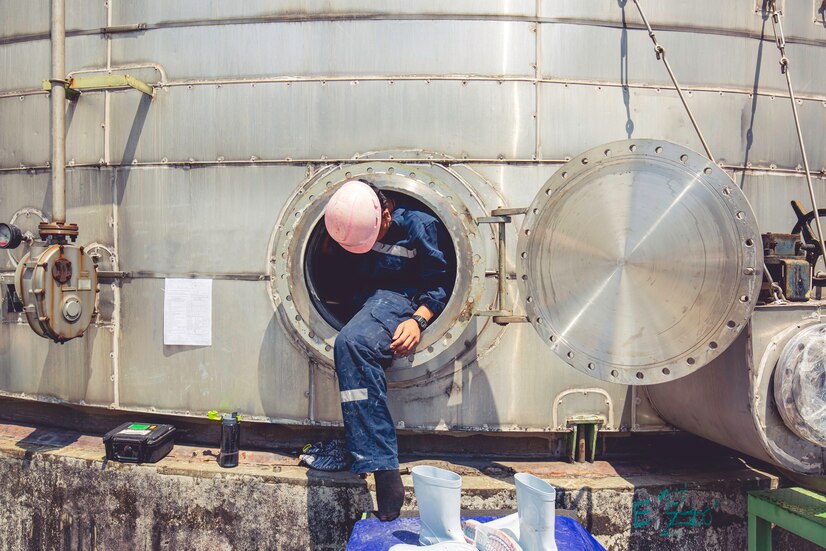
Storage tanks play a vital role in various industries, from water storage to chemical processing and fuel management. As such, proper tank maintenance and inspection are critical for ensuring optimal performance, safety, and compliance with industry regulations. This ultimate guide is designed to help you maintain and inspect your storage tanks cost-effectively by sharing effective strategies and solutions to achieve long-term success.
With a focus on preventive measures, risk assessments, and inspection planning, we’ll explore how you can optimise tank performance, extend the service life of your storage system, and avoid costly repairs or replacements.
Whether you manage a single storage tank or an extensive network of industrial tanks, this comprehensive guide will equip you with the knowledge to implement a cost-effective tank maintenance and inspection program tailored to your specific needs and objectives.
Implement Preventive Maintenance Measures
One of the most effective ways to achieve cost-effective tank maintenance is through preventative measures. These proactive steps can help identify and address potential issues before they escalate, resulting in costly repairs or tank failure. Key preventive maintenance measures include:
1. Regular tank inspections: Conduct routine visual inspections of the tank’s exterior and interior to identify signs of corrosion, leaks, or structural damage. Schedule more in-depth inspections by qualified professionals as required by regulations and industry best practices.
2. Ensuring proper installation: Ensure that tanks and liner systems are installed correctly, in accordance with manufacturer guidelines and industry standards, to minimise the likelihood of issues arising over time.
3. Using corrosion-resistant materials and coatings: Select materials with inherent corrosion resistance, or apply protective coatings to the tank’s interior and exterior surfaces to extend the tank’s lifespan and reduce maintenance costs.
Conduct Risk Assessments and Prioritise Inspections
Performing risk assessments can help you prioritise tank inspections and maintenance activities based on potential hazards and operational importance. This targeted approach can allow you to allocate resources more efficiently and ensure that high-risk storage tanks receive timely attention. To conduct a risk assessment for your storage tanks:
1. Identify potential hazards: Examine tank materials, contents, surrounding environmental conditions, and the likelihood of corrosion, leaks, or structural failure.
2. Evaluate the potential consequences: Assess the potential impacts associated with identified hazards, such as environmental damage, loss of stored materials, or regulatory non-compliance penalties.
3. Prioritise maintenance and inspections: Use the risk assessment outcomes to prioritise your tank maintenance and inspections, focusing on high-risk storage tanks and ensuring they receive prompt attention.
Develop an Inspection and Maintenance Plan
Developing a comprehensive inspection and maintenance plan can help streamline your storage tank maintenance efforts, ensuring timely and consistent upkeep. A robust plan should cover the following elements:
1. Inspection schedules: Outline the frequency and scope of routine inspections, as well as the intervals for more comprehensive examinations by qualified professionals.
2. Preventive maintenance tasks: List preventive maintenance tasks, such as cleaning, servicing valves, and monitoring cathodic protection systems, and assign appropriate frequencies and responsibilities for their completion.
3. Record-keeping and documentation: Establish processes for maintaining accurate records of inspection findings, repair works, and maintenance activities, to demonstrate compliance with regulations and inform future maintenance efforts.
Utilise Technological Solutions
Incorporating technology into your tank maintenance and inspection program can improve efficiency, accuracy, and cost-effectiveness. Some common technological solutions for storage tanks include:
1. Remote monitoring systems: Monitor tank levels, temperature, and pressure remotely using sensors and software. This enables you to track tank performance in real-time, quickly identify potential issues, and minimise the need for manual inspections.
2. Corrosion monitoring devices: Utilise tools like ultrasonic thickness gauges, which measure the remaining wall thickness of the tank and determine the extent of corrosion or erosion.
3. Automated inspection tools: Employ advanced inspection technologies such as drones, robotic crawlers, or 3D imaging to examine challenging areas or minimise the need for personnel entry into confined spaces.
Selection of Professional Service Providers
Working with professional tank maintenance and inspection providers can ensure your storage tank remains in optimal working condition and adheres to industry regulations. In selecting the right service provider, consider the following factors:
1. Experience and qualifications: Ensure that the maintenance provider has relevant experience in inspecting and maintaining storage tanks and holds necessary certifications, such as NACE or API qualifications, where applicable.
2. Comprehensive service offerings: Choose a provider that offers a full range of inspection and maintenance services, including preventive measures, repairs, and liner installations or replacements.
3. Commitment to safety and compliance: Select a provider with a strong commitment to safety and compliance, adhering to industry best practices and guidelines throughout the inspection and maintenance process.
Invest in Training and Education
Educating and training your staff on the basics of storage tank maintenance and inspection can contribute to more efficient operations and reduce the potential for costly mistakes. Consider conducting internal training sessions, or partnering with professional service providers to offer workshops or seminars on topics such as industry best practices, regulatory requirements, and safety protocols in handling storage tanks.
By focusing on prevention, risk assessment, technology, training, and working with professional partners, you can implement a cost-effective tank maintenance and inspection plan that reduces downtime, extends the lifecycle of your storage system, and ensures compliance with industry standards and regulations.
Achieve Cost-Efficient Tank Maintenance with ATM Tanks
Cost-effective tank maintenance and inspection can be achieved by implementing preventive measures, conducting risk assessments, developing a comprehensive plan, utilising advanced technologies, selecting experienced service providers, and investing in staff training. By adopting these strategies, you can optimise tank performance, reduce downtime, minimise the need for costly repairs, and ensure compliance with industry standards and regulations.
At ATM Tanks, we are committed to delivering customer-focused tank maintenance and inspection services tailored to your specific needs. Our qualified and experienced team can provide expert guidance, support, and solutions to help you achieve a robust, cost-effective tank maintenance program.
Don’t wait any longer to improve the efficiency and effectiveness of your storage tank management; contact TM Tanks today!

